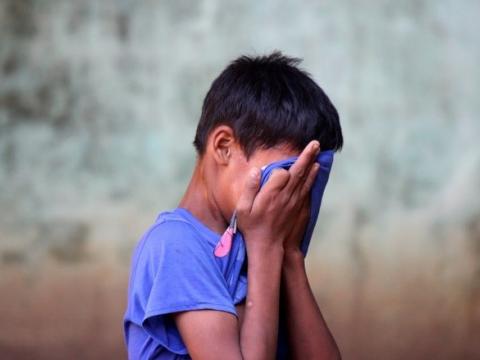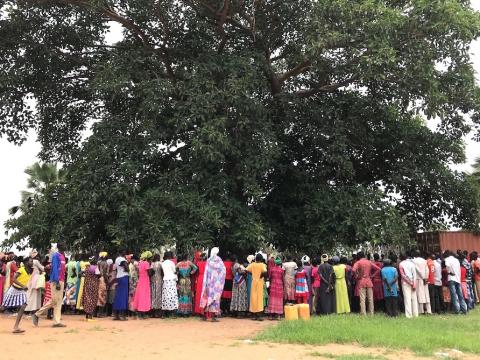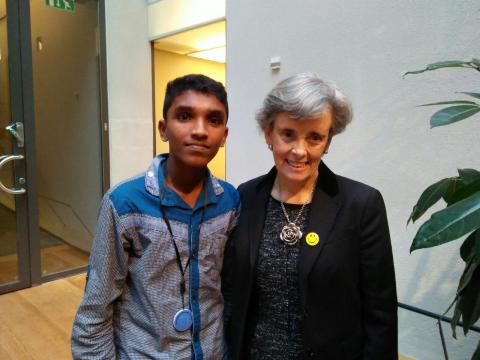
What’s it going to take?
By Dr Mirela Oprea
“Nine years, two months and three days.” These words recently jumped out at me after landing in my inbox as part of a newsletter from the Partnership to End Violence against Children. That is how long we have to end violence against children and deliver the Sustainable Development Goals.
And to my surprise, I realised that I am not that optimistic: I am pretty worried we are not going to end violence against children in the next nine years, two months and three days unless… unless we take behaviour change very seriously and put it at the centre of all we do. Here’s why…
When World Vision started our global campaign to end violence against children, it brought a long-buried memory to the surface. When I was about 12 years old, my friends and I would talk about how our parents used to “discipline” us. There were those whose dinners were maliciously withheld, those whose parents stopped talking to them for days and weeks on end, those who were hit with a wooden spoon or with dad’s belt, those who were forbidden to play with their favourite toys or wear their favourite clothes, those who were constantly yelled at to the point of fantasising suicide, those who were cruelly humiliated in front of other children, those who were locked outside during cold winter evenings by drunk fathers. We listened to each other’s stories and we were happy that we were ‘only’ spanked or yelled at, rather than being also humiliated or thrown outside. Or vice-versa. Each of us was thinking how lucky we were to ‘only’ get the kind of violence we were already used to. None of us even formed the thought that we should not get any at all. We were brain-washed to think about ourselves as bad children who deserved all the violence we got.
Stirred by the memories, I spoke publicly about the importance of ending violence against children, sharing about my own experience. I reflected that to break the cycle of violence we need to name it, talk about it, remember it and even honour it (when it happened to us) so that we can heal it in ourselves, in those who perpetrated it against us and in wider society. To my complete astonishment, instead of sympathy (let alone empathy or compassion) people of my parents’ age (including some of their friends), were saying things like: “How I wish I had raised my children as those parents. My children are a disappointment. I should have done more for them.”
I was stunned! I was being confronted by people who think that violence against children is actually good for children! They believe it toughens them. Teaches them lessons. Makes them reason. And that’s when I realised that if we want to be effective, we need to better understand and speak to people’s beliefs. We need to put aside what we think people believe and need, and courageously investigate their real beliefs and their real needs.
World Vision’s global research at the beginning of the campaign was a key step in this direction. And our office in Romania went one step further – we conducted a segmentation study – one of the first of its kind in the world – to better understand people’s beliefs and attitudes about violence against children:
- More than half (51%) of those surveyed said harsh discipline is good for children. We called them ‘the moral justifiers’.
- 10% were blamers, and said it was the child’s fault (the child is bad – they make me beat them)
- 8% were religious justifiers: the Bible says ‘spare the rod and spoil the child’, so violently punishing children is almost a sacred duty
- 5% said they hit children because everybody else did it; they’re the social justifiers

We have often hoped that information delivery will lead to changed attitudes, which in turn will lead to changed behaviours. Professor Jeni Cross says that this is one of the big myths of behaviour change, because only rarely this continuum (information delivery -> attitude change -> behaviour change) verifies. The result: more than half of the world’s children are still suffering from a form of violence.
Adults do not change their behaviours in relation to children just because we insist they should. That information bounces back: “Why would I stop beating my children if the Bible asks me so (perceived divine will)? Why would I stop hitting children if this is what will help them to become good adults (false perception of action efficacy)? Why would I stop punitive discipline if all neighbours do it and expect me to do it as well (perceived social norms)?”
So what to do, then? Let us look at the water, sanitation and hygiene (WASH) sector for a moment. Campaigners in this sector clearly identify a desired change – washing hands – and use a combination of instructional messages such as “Wash your hands with water and soap at these five critical moments during the day”. They know, because of research, that if people do this, they will cut the rates of child sickness, improve the survival of new-born children and so on. But once they understand the desired behaviours, WASH experts do not stop there. They conduct subsequent studies to understand why people are not washing their hands. They discover and tackle the access problem (by providing clean water and soap), and to understand and fix the action-efficacy-perception problem (educating people about why washing hands can be useful). And, as we have seen throughout this pandemic, they work with faith leaders to address belief systems.
We are using these approaches in our struggle to end violence against children, but a much larger, collective effort is needed if we are to ever realise our dream of ending this violation of children’s rights. Let alone in the next nine years, two months and three days.
We need to:
- Talk about the behaviours that we want to promote, as opposed to the behaviours we want people to stop.
- Understand whose behaviours need to change: the target groups and the influence groups (meaning those people who can influence the targets group). Never underestimate the role of faith leaders, community leaders, friends, and caregivers inside and outside the home, in this.
- Conduct formative research to understand what could possibly motivate people to perform the desired behaviour change, and their motivators and barriers to change. The factors that influence the desired practice can be internal (such as attitudes and beliefs), social (norms), or structural
- Generate targeted messages and interventions based on what we learn about those barriers and motivators (as opposed to what we think “is best”). We need to move beyond output (number of information delivery sessions, for examples) to behaviour outcomes (proportion of parents who adopt positive parenting methods, for example).
- Understand that behaviour change is like teaching reading (for instance): just because you have taught this generation of students, it doesn’t mean the next will know it automatically. Generation after generation of adults will need to learn about violence-free ways of relating with children. This is not a ‘once-and-for-all’ endeavour.
- Advocate for programmes and funding that are rooted in the science of behaviour change. Sadly, violence against children is not high on the agenda of the donors which fund social and behaviour change initiatives.
Dr Mirela Oprea the Social Norms and Behaviour Change Advisor for World Vision's global campaign It takes a world to end violence against children. Follow Mirela on Twitter @miruoprea

